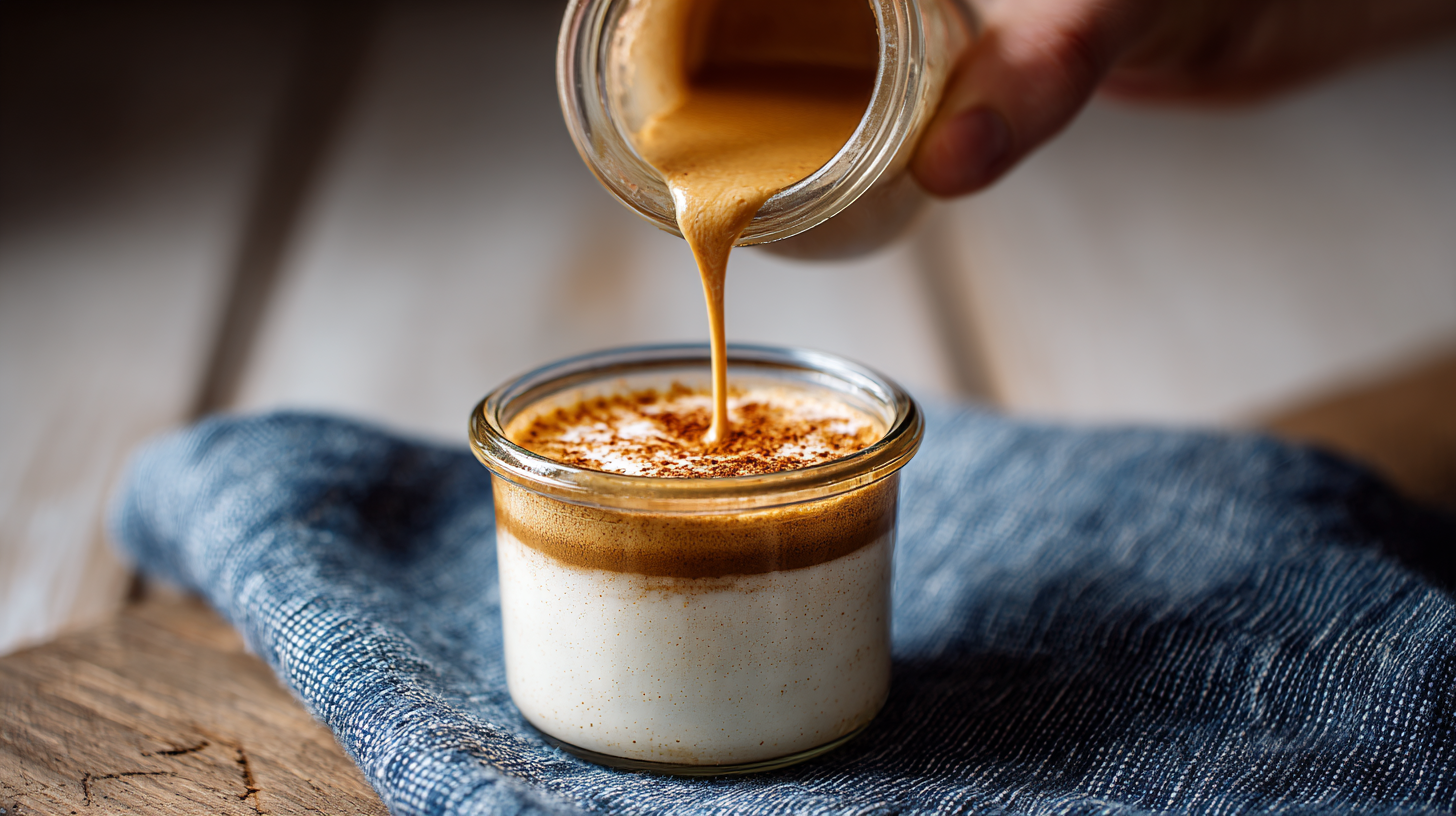
Ultimate Guide to Choosing the Right Best Coffee Creamer for Your Daily Brew
In recent years, the coffee creamer market has seen significant growth, reflecting a soaring consumer demand for diverse flavors and alternative options. According to a report by Grand View Research, the global coffee creamer market is expected to reach over $4 billion by 2025, driven by the increasing popularity of specialty coffee beverages. With a wide range of products available—from traditional dairy creamers to non-dairy and flavored varieties—selecting the right coffee creamer for your daily brew can be a daunting task. Understanding the characteristics and appropriate uses of each type is vital for enhancing your coffee experience. This ultimate guide will delve into the different kinds of coffee creamers available, helping you make an informed choice that caters to your taste preferences and dietary needs.

Understanding Coffee Creamer Types: Liquid vs. Powdered Options
When selecting the ideal coffee creamer for your daily brew, understanding the difference between liquid and powdered options is essential. The global whipped cream market is projected to reach a value of $2.63 billion by 2024, with a notable segment dedicated to whipped creamers, which are expected to achieve $1.48 billion in 2024 and grow to $1.77 billion by 2030. This growth is driven by the rising consumer preference for versatile and flavorful coffee enhancements.

Whipped creamers, whether in powdered or liquid form, offer unique benefits. Liquid creamers often provide a rich and creamy texture, ideal for enhancing the mouthfeel of your coffee. On the other hand, powdered creamers are convenient and have a longer shelf life, making them a popular choice among busy individuals. Composed of plant oils, sugars, and emulsifiers, both types create a stable foam that elevates the overall coffee experience. As consumer demand for innovative coffee products continues to rise, the coffee creamer market is ripe for exploration, catering to various tastes and preferences.
Key Ingredients in Coffee Creamers: What to Look For
When choosing the right coffee creamer for your daily brew, understanding the key ingredients is essential. According to a 2021 industry report by Mintel, nearly 40% of coffee drinkers in the U.S. prefer creamers that are dairy-free, highlighting the demand for alternative base ingredients. Popular choices include almond, coconut, and oat milk, each offering unique flavors and health benefits that cater to a variety of dietary needs.
Additionally, it's important to examine the sweeteners and additives in your coffee creamer. A study from the International Dairy Foods Association (IDFA) indicates that consumers are increasingly wary of artificial sweeteners, with 60% opting for natural options like cane sugar or stevia. This trend reflects a broader move towards clean-label products, which emphasize transparency and simplicity in ingredient lists. By focusing on the key elements such as dairy vs. non-dairy, natural vs. artificial sweeteners, and added flavors, you can choose a coffee creamer that not only enhances your brew but also aligns with your health and lifestyle preferences.
Nutritional Comparisons: Calories, Fats, and Sugar Content
When selecting the perfect coffee creamer, understanding the nutritional differences is crucial. A recent study published in the *Journal of Food Science* highlighted that traditional creamers can contain over 50 calories per serving, while many non-dairy alternatives range from 10 to 30 calories. With increasing health consciousness, consumers are looking for options that can enhance their brew without adding excessive calories. Creamers made from almond, coconut, or oat bases often provide a lower calorie alternative, making them popular choices among health-minded coffee drinkers.
Another important factor to consider is the fat and sugar content. A survey from the International Coffee Organization noted that many popular creamers can contain upwards of 5g of fat and 6g of sugar per serving. Opting for unsweetened or light versions can significantly cut down on these numbers. For those monitoring their sugar intake, it’s advisable to check labels before purchasing. Look for creamers that are labeled as “sugar-free” or “light” to ensure you’re not inadvertently adding unnecessary sugar to your morning cup.
**Tip:** When choosing a creamer, consider plant-based options for lower fat content without sacrificing flavor. Check for creamers fortified with nutrients like calcium and vitamin D for added health benefits. Finally, always check ingredient lists—creamer with whole, recognizable ingredients can often be a better choice for your daily brew.
Ultimate Guide to Choosing the Right Best Coffee Creamer for Your Daily Brew - Nutritional Comparisons: Calories, Fats, and Sugar Content
| Creamer Type | Calories (per tablespoon) | Total Fat (g) | Saturated Fat (g) | Sugar (g) |
|---|---|---|---|---|
| Dairy Creamer | 30 | 3 | 2 | 1 |
| Almond Milk Creamer | 15 | 1 | 0 | 1 |
| Soy Milk Creamer | 30 | 2 | 0 | 1 |
| Coconut Milk Creamer | 50 | 5 | 4 | 1 |
| Flavored Non-Dairy Creamer | 35 | 2 | 1 | 5 |
Major Industry Standards: Ensuring Quality in Coffee Creamer Production
When it comes to selecting the perfect coffee creamer, understanding the major industry standards in production is essential for ensuring quality. The coffee creamer market is diverse, with options ranging from non-dairy alternatives to flavored creamers. Manufacturers must adhere to strict regulations set by agencies like the Food and Drug Administration (FDA) to guarantee that their products are safe for consumption. These standards dictate the use of permitted ingredients, proper labeling, and nutritional information, allowing consumers to make informed choices.
Furthermore, industry standards encompass quality assurance protocols that monitor the manufacturing process, from sourcing raw materials to the final packaging. Producers often implement rigorous testing to assess factors such as taste, texture, and shelf stability. Certifications from reputable organizations, like the International Organization for Standardization (ISO), can also signify adherence to high-quality production practices. By paying attention to these standards, consumers can not only elevate their daily brew but also support brands committed to delivering the best coffee creamer experience while ensuring their health and satisfaction.
Ultimate Guide to Choosing the Right Best Coffee Creamer for Your Daily Brew
How to Choose the Best Coffee Creamer for Your Dietary Needs
When choosing the best coffee creamer for your dietary needs, it’s essential to consider various factors such as ingredients, flavor, and nutritional content. With quality consumption on the rise, consumers are increasingly leaning towards brands that not only provide flavorful options but also align with their health considerations. For those who are lactose intolerant or following a plant-based diet, exploring alternatives like almond, oat, or the new wave of plant-based creamers can be beneficial. These options often come with added nutrients that cater to specialized dietary preferences, ensuring a creamy texture without compromising health.

Furthermore, the coffee creamer market is evolving, predicted to grow significantly in the coming years. As innovations emerge, including unique blends and flavors that cater to specific consumer trends, it’s vital to stay informed about new products hitting the market. Additionally, brands are focusing on transparency when it comes to ingredient sourcing and nutrition labels, aligning with consumer demand for high-quality and reliable options. This trend emphasizes the importance of making informed choices that not only enhance the coffee experience but also meet individual dietary needs effectively.
